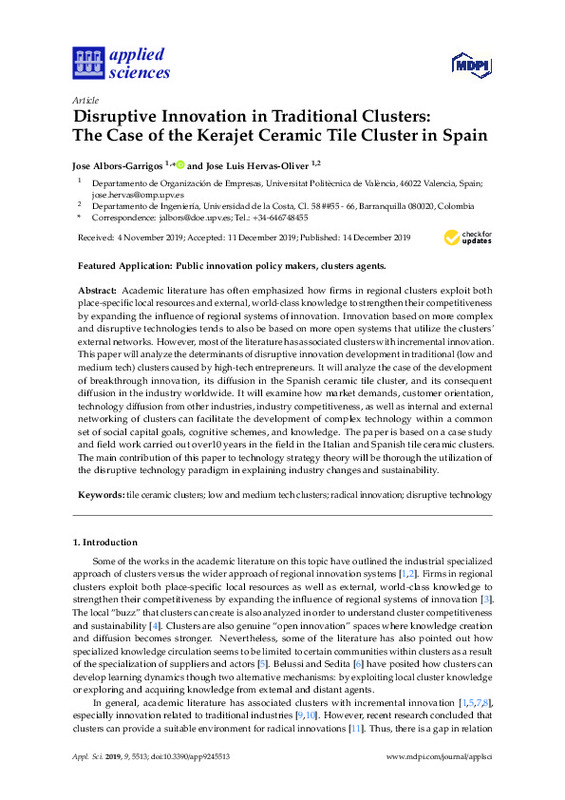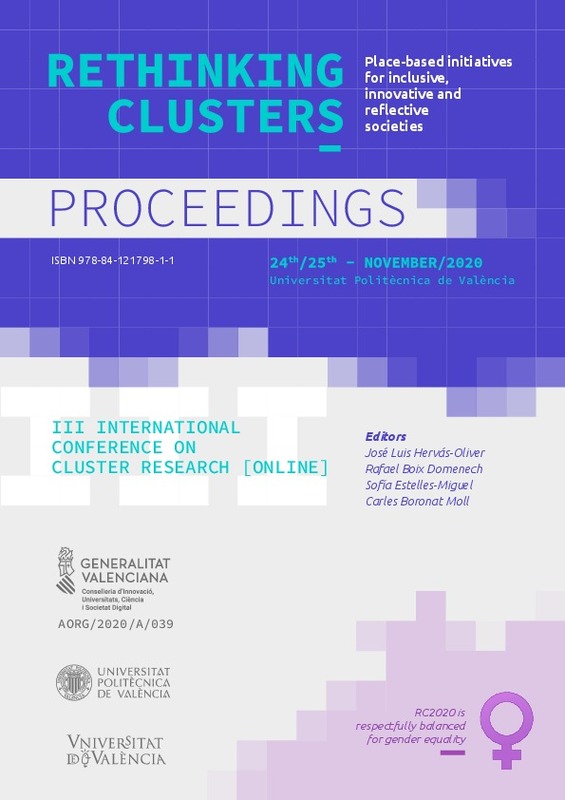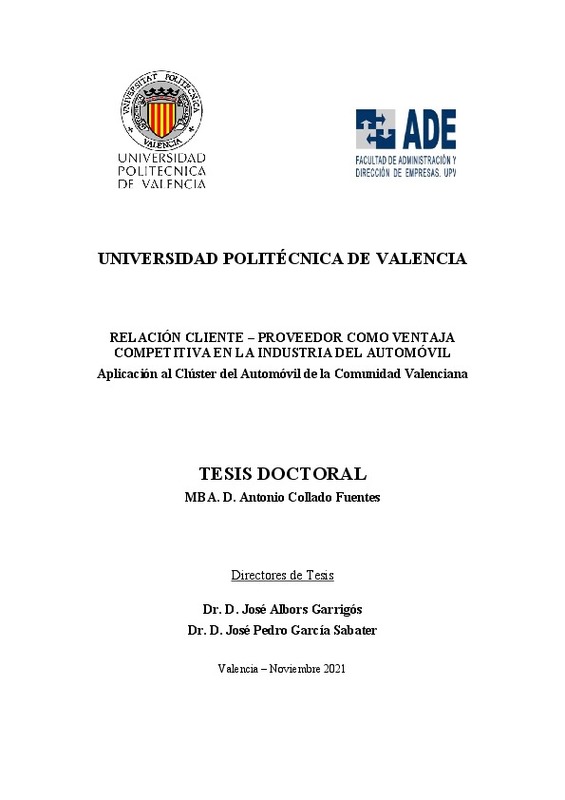Asheim, B. T., & Coenen, L. (2005). Knowledge bases and regional innovation systems: Comparing Nordic clusters. Research Policy, 34(8), 1173-1190. doi:10.1016/j.respol.2005.03.013
Asheim, B. T., Smith, H. L., & Oughton, C. (2011). Regional Innovation Systems: Theory, Empirics and Policy. Regional Studies, 45(7), 875-891. doi:10.1080/00343404.2011.596701
Lissoni, F. (2001). Knowledge codification and the geography of innovation: the case of Brescia mechanical cluster. Research Policy, 30(9), 1479-1500. doi:10.1016/s0048-7333(01)00163-9
[+]
Asheim, B. T., & Coenen, L. (2005). Knowledge bases and regional innovation systems: Comparing Nordic clusters. Research Policy, 34(8), 1173-1190. doi:10.1016/j.respol.2005.03.013
Asheim, B. T., Smith, H. L., & Oughton, C. (2011). Regional Innovation Systems: Theory, Empirics and Policy. Regional Studies, 45(7), 875-891. doi:10.1080/00343404.2011.596701
Lissoni, F. (2001). Knowledge codification and the geography of innovation: the case of Brescia mechanical cluster. Research Policy, 30(9), 1479-1500. doi:10.1016/s0048-7333(01)00163-9
Belussi, F., & Sedita, S. R. (2012). Industrial Districts as Open Learning Systems: Combining Emergent and Deliberate Knowledge Structures. Regional Studies, 46(2), 165-184. doi:10.1080/00343404.2010.497133
Steinle, C., & Schiele, H. (2002). When do industries cluster? Research Policy, 31(6), 849-858. doi:10.1016/s0048-7333(01)00151-2
Giuliani, E. (2007). The wine industry: persistence of tacit knowledge or increased codification? Some implications for catching-up countries. International Journal of Technology and Globalisation, 3(2/3), 138. doi:10.1504/ijtg.2007.014330
Hervas-Oliver, J.-L., & Albors-Garrigos, J. (2008). The role of the firm’s internal and relational capabilities in clusters: when distance and embeddedness are not enough to explain innovation. Journal of Economic Geography, 9(2), 263-283. doi:10.1093/jeg/lbn033
Grashof, N., Hesse, K., & Fornahl, D. (2019). Radical or not? The role of clusters in the emergence of radical innovations. European Planning Studies, 27(10), 1904-1923. doi:10.1080/09654313.2019.1631260
Dubé, & Paré. (2003). Rigor in Information Systems Positivist Case Research: Current Practices, Trends, and Recommendations. MIS Quarterly, 27(4), 597. doi:10.2307/30036550
Molina-Morales, F. X. (2002). Industrial districts and innovation: the case of the Spanish ceramic tiles industry. Entrepreneurship & Regional Development, 14(4), 317-335. doi:10.1080/08985620210144992
Estudio Económico del Sector del Azulejo 2018, Castellón (Spanish) http//www.ascer.es
Hervás-Oliver, J. L., & Albors-Garrigós, J. (2007). Do clusters capabilities matter? An empirical application of the resource-based view in clusters. Entrepreneurship & Regional Development, 19(2), 113-136. doi:10.1080/08985620601137554
Oliver, J. L. H., Garrigós, J. A., & Porta, J. I. D. (2008). External Ties and the Reduction of Knowledge Asymmetries among Clusters within Global Value Chains: The Case of the Ceramic Tile District of Castellon. European Planning Studies, 16(4), 507-520. doi:10.1080/09654310801983308
Assopiastrelle and Asia Observatore, Corporate Information www.assopiastrelle.it
Albors, J. G. (2002). The Journal of Technology Transfer, 27(3), 263-273. doi:10.1023/a:1015600521407
Belussi, F., & Rita Sedita, S. (2008). The Symbiotic Division of Labour between Heterogeneous Districts in the Dutch and Italian Horticultural Industry. Urban Studies, 45(13), 2715-2734. doi:10.1177/0042098008098202
Breschi, S., Malerba, F., & Orsenigo, L. (2000). Technological Regimes and Schumpeterian Patterns of Innovation. The Economic Journal, 110(463), 388-410. doi:10.1111/1468-0297.00530
Iammarino, S., & McCann, P. (2006). The structure and evolution of industrial clusters: Transactions, technology and knowledge spillovers. Research Policy, 35(7), 1018-1036. doi:10.1016/j.respol.2006.05.004
Robertson, P. L., & Patel, P. R. (2007). New wine in old bottles: Technological diffusion in developed economies. Research Policy, 36(5), 708-721. doi:10.1016/j.respol.2007.01.008
JOHN, C. H., & POUDER, R. W. (2006). Technology Clusters versus Industry Clusters: Resources, Networks, and Regional Advantages. Growth and Change, 37(2), 141-171. doi:10.1111/j.1468-2257.2006.00313.x
Beckman, C. M., & Haunschild, P. R. (2002). Network Learning: The Effects of Partners’ Heterogeneity of Experience on Corporate Acquisitions. Administrative Science Quarterly, 47(1), 92. doi:10.2307/3094892
Abernathy, W. J., & Clark, K. B. (1985). Innovation: Mapping the winds of creative destruction. Research Policy, 14(1), 3-22. doi:10.1016/0048-7333(85)90021-6
Ettlie, J. E., Bridges, W. P., & O’Keefe, R. D. (1984). Organization Strategy and Structural Differences for Radical Versus Incremental Innovation. Management Science, 30(6), 682-695. doi:10.1287/mnsc.30.6.682
Tushman, M. L., & Anderson, P. (1986). Technological Discontinuities and Organizational Environments. Administrative Science Quarterly, 31(3), 439. doi:10.2307/2392832
Dewar, R. D., & Dutton, J. E. (1986). The Adoption of Radical and Incremental Innovations: An Empirical Analysis. Management Science, 32(11), 1422-1433. doi:10.1287/mnsc.32.11.1422
Green, S. G., Gavin, M. B., & Aiman-Smith, L. (1995). Assessing a multidimensional measure of radical technological innovation. IEEE Transactions on Engineering Management, 42(3), 203-214. doi:10.1109/17.403738
Coccia, M. (2015). Radical innovations as drivers of breakthroughs: characteristics and properties of the management of technology leading to superior organisational performance in the discovery process of R&D labs. Technology Analysis & Strategic Management, 28(4), 381-395. doi:10.1080/09537325.2015.1095287
Adner, R. (2002). When are technologies disruptive? a demand-based view of the emergence of competition. Strategic Management Journal, 23(8), 667-688. doi:10.1002/smj.246
Adner, R., & Kapoor, R. (2015). Innovation ecosystems and the pace of substitution: Re-examining technology S-curves. Strategic Management Journal, 37(4), 625-648. doi:10.1002/smj.2363
Danneels, E. (2004). Disruptive Technology Reconsidered: A Critique and Research Agenda. Journal of Product Innovation Management, 21(4), 246-258. doi:10.1111/j.0737-6782.2004.00076.x
Markides, C. (2006). Disruptive Innovation: In Need of Better Theory*. Journal of Product Innovation Management, 23(1), 19-25. doi:10.1111/j.1540-5885.2005.00177.x
Tellis, G. J. (2006). Disruptive Technology or Visionary Leadership?*. Journal of Product Innovation Management, 23(1), 34-38. doi:10.1111/j.1540-5885.2005.00179.x
Von Hippel, E. (1986). Lead Users: A Source of Novel Product Concepts. Management Science, 32(7), 791-805. doi:10.1287/mnsc.32.7.791
Chesbrough, H. (2010). Business Model Innovation: Opportunities and Barriers. Long Range Planning, 43(2-3), 354-363. doi:10.1016/j.lrp.2009.07.010
Schmidt, G. M., & Druehl, C. T. (2008). When Is a Disruptive Innovation Disruptive? Journal of Product Innovation Management, 25(4), 347-369. doi:10.1111/j.1540-5885.2008.00306.x
Isaksen, A. (2018). From success to failure, the disappearance of clusters: a study of a Norwegian boat-building cluster. Cambridge Journal of Regions, Economy and Society, 11(2), 241-255. doi:10.1093/cjres/rsy007
Glasmeier, A. (1991). Technological discontinuities and flexible production networks: The case of Switzerland and the world watch industry. Research Policy, 20(5), 469-485. doi:10.1016/0048-7333(91)90070-7
Hervas-Oliver, J.-L., & Albors-Garrigos, J. (2014). Are technology gatekeepers renewing clusters? Understanding gatekeepers and their dynamics across cluster life cycles. Entrepreneurship & Regional Development, 26(5-6), 431-452. doi:10.1080/08985626.2014.933489
Hervas-Oliver, J.-L., Sempere-Ripoll, F., Estelles-Miguel, S., & Rojas-Alvarado, R. (2019). Radical vs incremental innovation in Marshallian Industrial Districts in the Valencian Region: what prevails? European Planning Studies, 27(10), 1924-1939. doi:10.1080/09654313.2019.1638887
Albors, J., & Hervás, J. L. (2006). La industria cerámica europea en el siglo XXI. Retos tecnológicos y desafíos de la próxima década. Boletín de la Sociedad Española de Cerámica y Vidrio, 45(1), 13-21. doi:10.3989/cyv.2006.v45.i1.323
Utterback, J. M., & Abernathy, W. J. (1975). A dynamic model of process and product innovation. Omega, 3(6), 639-656. doi:10.1016/0305-0483(75)90068-7
Assink, M. (2006). Inhibitors of disruptive innovation capability: a conceptual model. European Journal of Innovation Management, 9(2), 215-233. doi:10.1108/14601060610663587
Munari, F., Sobrero, M., & Malipiero, A. (2011). Absorptive capacity and localized spillovers: focal firms as technological gatekeepers in industrial districts. Industrial and Corporate Change, 21(2), 429-462. doi:10.1093/icc/dtr053
Landry, R., Amara, N., & Lamari, M. (2002). Does social capital determine innovation? To what extent? Technological Forecasting and Social Change, 69(7), 681-701. doi:10.1016/s0040-1625(01)00170-6
Angel, D. P. (2002). Inter-firm Collaboration and Technology Development Partnerships Within US Manufacturing Industries. Regional Studies, 36(4), 333-344. doi:10.1080/00343400220131115
Tallman, S., Jenkins, M., Henry, N., & Pinch, S. (2004). Knowledge, Clusters, and Competitive Advantage. Academy of Management Review, 29(2), 258-271. doi:10.5465/amr.2004.12736089
Cohen, W. M., & Levinthal, D. A. (1990). Absorptive Capacity: A New Perspective on Learning and Innovation. Administrative Science Quarterly, 35(1), 128. doi:10.2307/2393553
[-]












